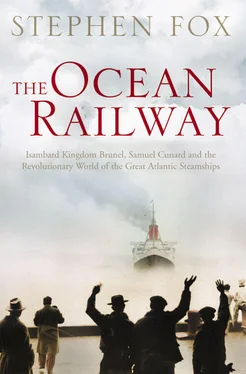If this early crisis had turned a certain way, it could have killed the whole enterprise at the outset. Instead it turned another way and gave the scheme a wider, more secure base, transformed it, and set up the leadership structure that would run the Cunard Line for decades. Napier, now less sure of his new partner, felt obliged to protect his own local reputation for sound dealings. Stepping back, he went around Cunard and confided in Robert Rodger, the Glasgow banker who had doubted Cunard’s credit. ‘ I have no wishto put you to the least trouble or inconvenience on my account,’ he assured Rodger. ‘The transaction with Mr Cunard is of such a magnitude that I must not have the least risk of trouble or anxiety about the money part of it.’ The two Glaswegians, acting in their respective self-interests, came up with a protective local solution. They invited other investors into the scheme to provide the cash cushion that was manifestly beyond Cunard’s overstretched resources.
As part of this manoeuvre, they also brought in local experts at running a steamship line, George Burns and the brothers David and Charles Mac Iver. Former rivals, for almost a decade these three men had together been operating profitable coastal steam packets between Glasgow and Liverpool. If Burns and the Mac Ivers were involved, Napier urged Cunard, ‘ the vessels wouldbe well and honestly managed, and save much trouble to all concerned and make money.’ Furthermore, though contrary to his usual practice, given their participation Napier might himself take ‘a small interest’ in the venture: a rippling expression of confidence sure to lure other investors in Glasgow. ‘ I have severaloffers but am bound to no one,’ Cunard replied to Napier. ‘I should much like to have you and your friends with me.’ Within a few days, Napier and Burns found their partners (mainly interested businessmen in Glasgow), thus delivering the venture from the uncertainties of Cunard’s own money and – most significantly – binding its future to the Clyde. ‘I want to shew the Americans what can be done in Glasgow,’ Cunard reminded Napier, turning several screws, ‘and that neither Bristol or London boats can beat them.’
From that point, the pieces all fell into place quickly. In June 1839 Cunard, Burns and David Mac Iver signed the final revised contract with the Admiralty for the mail service. It called for four steamships of 400 horsepower, 206 feet long, and 1120 tons, sailing twice each month between Liverpool and Halifax, and then Halifax and Boston, for the government’s payment of £60,000 a year for seven years. (The designation of Liverpool, headquarters of the Mac Ivers’ coastal packets, reflected the transatlantic enterprise’s new ownership structure.) The first ships were to be ready for sea by May 1840. Napier would build the engines, and to meet the soon-looming deadline the ships’ construction was parcelled out to four different Clyde shipbuilders. (‘ I dare sayI get a good deal of credit for it, but I am not entitled to it,’ Cunard later said of his first steamships. ‘Any credit that there may be in fixing upon the vessels of proper size and proper power is entirely due to Mr. Napier, for I have not the science myself; he gave me the dimensions.’)
In the final partnership agreement, Cunard took the largest portion at £55,000. James Donaldson, the leading cotton broker in Glasgow, took the next biggest piece at £16,000, followed by eight others at £11,600. Napier threw in £6100, Burns £5500, and the Mac Ivers £4000 each. In all, thirty-three investors from Glasgow, Liverpool and Manchester provided a total working capital of £270,000. Napier had brokered the whole deal and henceforth was deeply involved, in effect working for himself as both the engine builder and a part owner. Cunard remained the central figure, the founder and ultimate boss. ‘ I had the wholeinterest for some time in the original contract,’ he later explained. ‘But circumstances turned up which made it necessary that I should part with some portion, and I did; but I have still the management.’ The official name was the British and North American Royal Mail Steam Packet Company. From the start, it was known more simply as Cunard’s line or the Cunard Line.
The first four ships of the line were, as Cunard had directed, plain and comfortable, with no unnecessary expense for show. The keels were laid almost simultaneously within a small circle of shipbuilders along the Clyde. John Wood crafted and built the Acadia, the pattern for the others. His brother Charles Wood built the Caledonia; Robert Steele, the Columbia; and Robert Duncan, the Britannia. (The names of the ships made careful, portioned reference to Nova Scotia, Scotland, the United States and Great Britain, the four places that had launched and would then sustain the Cunard Line.) The ships had essentially identical dimensions, varying only in slight particulars: 207 feet long, 34 feet wide, and about 1150 tons. John Wood was well known for the grace and comely proportions of his wooden hulls. ‘ Remarkable for the greatrefinement of his taste,’ the naval architect John Scott Russell, a noted contemporary, later said of Wood. ‘He was a consummate artist in shipbuilding, and every line was as studied and beautiful as fine art could make it.’ The Cunard ships were austere beauties, sleek and black, with just a few ornamental touches of gold and red in the paddle boxes and smokestack.
As expressions of steamship technology, they started a durable Cunard tradition of summarizing recent progress in the field and adding only small, careful improvements: advancing the art but not by any risky grand leaps. They embodied the habitual technological caution – ships as enterprise, not as engineering – of their two main creators. Sam Cunard had crossed on both the Great Western and British Queen, and Robert Napier knew the latter ship well from providing her engine. Traces of these transatlantic predecessors showed up in the Cunard vessels. They were lavishly trussed and bolted, like the Great Western, with (for example) ‘ two strong bilge-piecesin the engine room’, as Napier’s contract with Cunard made explicit, ‘similar to what is in the “British Queen” steam ship and well bolted.’ To avoid the Great Western’s initial difficulties over retrieving coal from distant holds at the bow and stern, the Cunard ships carried their fuel in midship compartments lining the sides of the vessels, from which the coal simply descended by gravity to trapdoors near the furnaces. Ambient heat from the Great Western’s boilers had made nearby areas feel and smell uncomfortably cooked; so the Cunard ships included a thick, coarse woollen cloth underneath the cabin floors and on bulkheads around the engine rooms ‘secured by beams and knees’, the contract specified, ‘so arranged that a space can be left for air courses to ventilate and carry off the heated air and gases.’ The cycloidal Great Western paddle wheels devised by Joshua Field had not worked well; Napier gave the Cunard ships conventional paddles.
Designed to carry mail, not cargo, they were smaller than the Great Western and British Queen— but a bit faster, with slightly higher ratios of horsepower to tonnage. Napier’s newest engines squeezed more power from less fuel by almost doubling the Great Western’s boiler steam pressure, from five to nine pounds per square inch, which helped reduce average coal consumption from forty-four to thirty-eight tons a day. Within a year of the Britannia’s maiden voyage to Boston in July 1840, the Cunard ships had beaten the Great Western’s Atlantic records in both directions, achieving peak average speeds of almost ten knots out and eleven knots home, and cutting the best eastbound passage to just under ten days. Over the first two years, as a fleet they averaged thirteen days, six hours to Halifax and eleven days, five hours to Liverpool. The overmatched Great Western company, competing on its own with just one steamship against four newer, faster vessels backed by the authority and prestige of the government’s mail contract, began to lose passengers and profits to the Cunard Line.
Читать дальше












